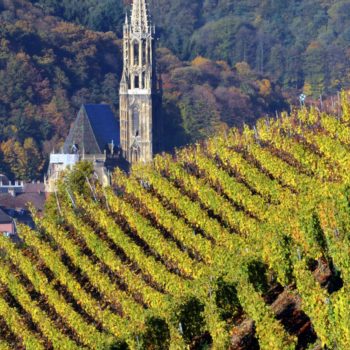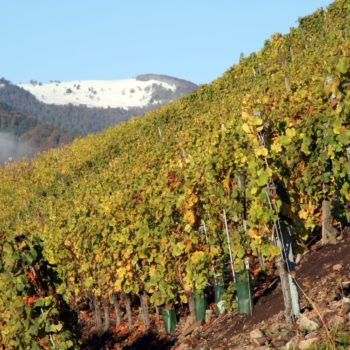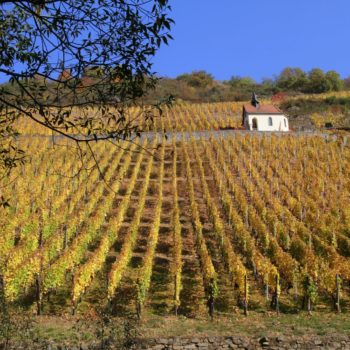


As a young boy, iI spent my childhood in this wonderful region of the RANGEN. There were then only a few small vineyards. It was wild countryside populated with pheasant, roe-deer, hares and foxes… There were also many wild fruits. We indulged ourselves thoroughly: wild strawberries, blackberries, raspberries… A paradise for nature-loving children.
Then came the revival of the vineyard and the reconquest of its reputation. As a student, I came back every weekend to help my father take care of the family vineyard that we were the rare ones to preserve.
My ambition came at this far-off time: one day, I said to myself, “I will create a vaster vineyard and I will make my own wine”.
Wine. Just like the famous wine of the winegrowers who settled around us. Over the years I realized this wish – I took over fields and planted them with the varieties of vine which glorify so well the Grand Cru of the Rangen. The expertise of the vines grew alongside the expertise in the wine cellar, another place where the wine-grower needs to practice a real Art. Our wines are recognized for their specificity and technical quality. That is enough for happiness!
And the man I have become, still plants grapevines on the land with the precious help of the three daughters Claire, Léa and Marie that my wife, Dominique gave to me.
After studying oenology at Changins and Kedge Engineering School Business School in Bordeaux, Léa returned to her Thannois roots in January 2022 to take charge of the family estate.


Our vineyard extends above the lovely city of Thann. The “Rangenkopf” and its south side, the “Rangenberg”, both belong to the primary range of the Southern “Vosges” or the range of the “Ballons”. The Rangen is the only wine producing area in Alsace on volcanic rock. The association of silica rocks and basic lava provides a soil rich in fertilizing elements (calcium, magnesium, potassium…).
The hardness of the rock generates a stony soil and their dark colors are very favorable factors for the accumulation of warmth. The steep slope and its orientation to the South place the Rangen in optimal sunshine conditions, particularly in autumn. In addition, we have the highest vineyard in Alsace (with an altitude of 455 meters).It is also one of those where rainfall is the heaviest (1000 mm on average per year).
Heavy rainfall is welcome considering the natural permeability of the soil and its steep slopes which allow maximum sunshine to reach the grapes of the vineyard. If the weather is cooler than elsewhere (owing to the winds and the altitude), this enables a certain balance to be established with the heat retained by the “Rangen Grauwackes”, real refractory rocks. Finally, the river is also very important. In autumn, it creates a morning mist which quickly dissipates on the south facing slopes of the vineyard. An aspect, which the steep gradients of the hills (up to 68°), makes more interesting. This conjunction between the morning mist and the accelerated evaporation favors the rot or “pourriture noble” (botrytis) on the grapes: a godsend for the late grape harvest.
